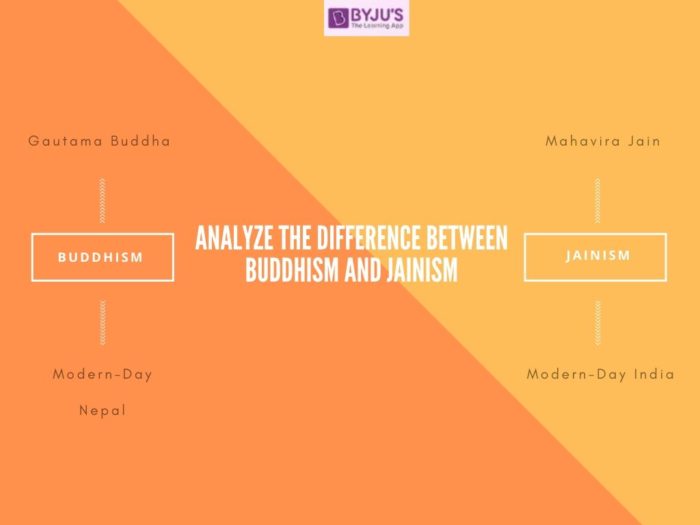Buddhism and Jainism are ancient religions that developed during the days of Ancient India. Buddhism is based on the teachings of Gautama Buddha, while Jainism is based on the teachings of Mahavira
Apart from this, there are many similarities between Buddhism and Jainism on grounds of terminology and ethical principles, but the way they are applied is different.
You can find more Difference Between Articles, by visiting the linked page

From this point on the key differences and similarities between Buddhism and Jainism will be highlighted within the context of IAS Exam
Differences between Buddhism and Jainism
| Buddhism |
Jainism |
| Rebirth is one of the principal beliefs in Buddhism. It is thought that the endless cycle of birth and re-birth can only be broken by attaining Nirvana (Enlightenment) | Jainism believes that the circle of rebirths and deaths will continue due to good or bad deeds until liberation is achieved |
| Scriptures include Tripitaka, which is a vast text consisting of 3 sections: the Discipline, the Discourse and the Commentaries. | Jain religious texts are called Agamas |
| The principal teaching of Buddhism is that life is suffering and to escape suffering (end cause of desire) one needs to dispel ignorance by realizing the Four Noble Truths and practising the Eightfold Path | Jainism lays emphasis on the respect of all living beings. Liberation from the cycle of rebirths is attained by taking the Five Vows and following the principles of the Three Jewels |
| Sin is not a concept in Buddhism | Sin is defined as harm to others |
| Buddhism is divided into two major sects upon the death of Gautama Buddha. They are the Mahayana and the Theravada | Svetambara and Digambara are the two major sects of Jainism |
| According to some texts in Buddhism, there are beings in heaven but they are bound by “samsara”. They suffer less bu they ave, not yet achieved salvation | Deities in Jainism are known as “Titrtheneakas”. But they are not worshipped in the conventional sense as they are regarded as wise teachers whose teachings must be followed |
| Buddhism was founded in modern-day Nepal by Prince Siddhartha in the 6th century B.C | Scholars of religion generally hold that Jainism originated in the 7th–5th century BC in Northern India. Mahavira, also known as Vardhamana was the 24th Tirthankara (Spiritual Teacher) of Jainism |
| Followers of Buddhism can be found mainly in Thailand, Cambodia, Sri Lanka, India, Nepal, Bhutan, Tibet, Japan, Myanmar (Burma), Laos, Vietnam, China, Mongolia, Korea, Singapore, Hong Kong and Taiwan | Followers of Jainism are found mainly in India, lower Asian subcontinent throughout, and America. Small groups exist in most countries |
After we have learnt about the key differences between Buddhism and Jainism, we will now examine the similarities between the two religions.
Similarities between Buddhism and Jainism
| Factors |
Explanation |
| Rejection of Vedas | Buddhism and Jainism rejected the notion of grand rituals along with the authority of the Vedas and the priestly class |
| Founders | Just like his contemporary, Gautama Buddha, Mahavir Jain was born into a royal family. Both of them renounced their comfortable lifestyle to attain enlightenment |
| Animal Rights | Both Buddhism and Jainism also stressed the principle of non-violence against animals and they must also be given equal respect as one gives to a fellow human being |
| Karma | Both Buddhism and Jainism believe in the concept of karma, which is an attachment of positive and negative forces to the soul based on a person’s actions, beliefs, and spiritual attachments. Reincarnation carries this force forward and requires effort to purify the soul. |
| God and Scripture | Neither religion believes in God as the creator of the universe. They acknowledge all creation as being part of the universe’s divinity. As such, their holy texts are not considered the word of a god or sacred stories. |
| Reincarnation | Buddhism and Jainism believe in the concept of reincarnation, which is the rebirth of the soul in a new body after the death of the previous body. |
Buddhism and Jainism are broadly covered under Indian History as well as the Art and Culture segment of the UPSC Exams. You can find the study materials for both these segment and related articles through the links given below:
- NCERT Ancient Indian History for UPSC
- NCERT Medieval Indian History for UPSC
- NCERT Modern Indian History for UPSC
- NCERT Notes about the teachings of the Buddha for UPSC
- List of Buddhist Councils and Texts
- Jainism in India
- NCERT Notes for Art and Culture UPSC
- Important Topics and Subtopics for UPSC Art and Culture
- How to tackle Art and Culture for UPSC IAS Prelims
- 100 Difference Between Articles for UPSC Revision
Difference Between Buddhism and Jainism – Download PDF Here
FAQ about Buddhism and Jainism
What are the two major schools of Buddhism?
What are the major sects in Jainism?
For more UPSC Exam related preparation materials visit the following links given below:
Related Links
| NCERT Books | UPSC Exam Pattern | Current Affairs Quiz |
| Current Affairs PDF | World Current Affairs | UPSC Syllabus in Hindi PDF |
| Green Revolution in India | Pradhan Mantri Matritva Vandana Yojana | Project Tiger |
Comments